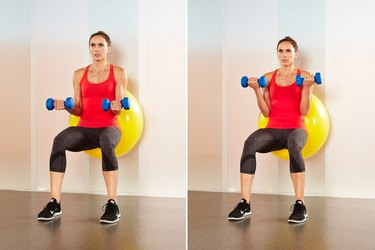
Sometimes more is a good thing, like when it comes to drinking water during the day or getting up to take standing breaks from your office chair. But when it comes to building your biceps muscle size or strength, more doesn't always equal bigger and better.
Regardless of your goals, there are some muscle-building basics to consider and apply to your training when it comes to your arms. Creating a program with the right sets and reps will help you build the bicep strength or size you're looking for.
Video of the Day
Video of the Day
Before you train biceps in your next workout, consider these tips from Maillard Howell, owner of CrossFit Prospect Heights and founder of The Beta Way.
Learn the Muscle-Building Basics
Lift weights, build muscle. Sounds easy enough, right? Well, before you pick up the pounds, there are some basic principles behind muscle building that you should know about.
First, let's talk hypertrophy, or the growth of muscle fibers and muscle size, according to the National Academy of Sports Medicine (NASM). While there are endless combinations of sets and reps you can use to achieve your goals, muscle growth always ties back to progressive overload. Over time, muscles adapt to the weight you use. In other words, curling 20-pound dumbbells week after week won't make your muscles grow larger or stronger — you need to up the ante.
Progressive overload involves strategically increasing the resistance you use in order to increase muscle tension, damage and stress, which is how muscles are strengthened, according to the NASM. Progressive overload can be done at a rapid or more steady pace, whether you want to increase the weights you use each workout, each week or every few weeks. Everyone is different, and there's no single overload formula that works all the time.
Using Sets and Reps to Increase Strength and Size
When you exercise your arms, it's important to maintain a well-rounded routine, according to the NASM. This means working on both hypertrophy and endurance. To achieve both goals, the NASM recommends beginning with moderate weights and repetitions and increasing sets and reps as you improve with time.
Your last few reps should be challenging, but you should be able to maintain good form, posture and technique throughout an entire set. If you feel your form collapse, though, you may need to decrease the weight.
The exact set and rep ranges you use depends on your goals, according to Howell. If you're training for strength, you may not want to increase muscle size too much, as bigger muscles sometimes get in the way in other exercises, Howell says.
Howell is a fan of relatively light weight and high volume (reps in the 12 to 15 range) for biceps training, as the volume will tax both slow- and fast-twitch muscle fibers over time. Incorporating a large variety of biceps exercises performed with high sets and high reps will also help you build bigger arm muscles.
Regardless of your goals, make sure to consult with a certified personal trainer for advice before beginning a consistent arm routine. Set yourself up smart, then you'll stave off injury and have the biceps to show for it.


